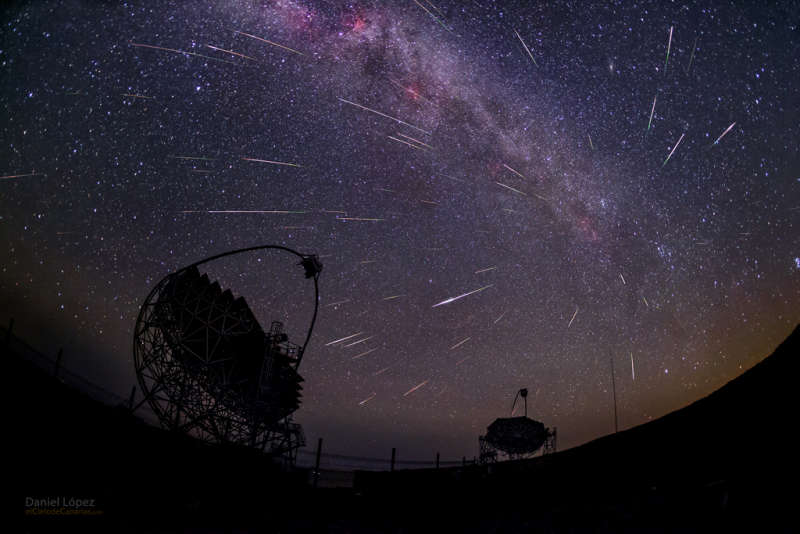Credit & Copyright: Daniel López
(El Cielo de Canarias)
Explanation:
Gamma-rays
and dust from periodic Comet Swift-Tuttle plowed through
planet Earth's atmosphere on the night of August 11/12.
Impacting at about 60 kilometers per second the grains of
comet dust produced this year's remarkably
active Perseid meteor shower.
This composite wide-angle image of aligned shower meteors
covers a 4.5 hour period on
that Perseid night.
In it the flashing meteor streaks can be traced
back to the shower's origin on the sky.
Alongside the Milky Way in the constellation Perseus,
the radiant marks the direction along the perodic
comet's
orbit.
Traveling at the speed of light, cosmic gamma-rays impacting Earth's
atmosphere generated showers too, showers of high energy particles.
Just as the meteor streaks point back to their origin, the
even briefer flashes of light from the particles can be used
to reconstruct the direction of the
particle
shower, to point
back to the origin on the sky of the incoming gamma-ray.
Unlike the meteors, the incredibly fast particle shower flashes
can't be followed by eye.
But both
can be followed by the high speed cameras on the
multi-mirrored dishes in the foreground.
Of course, the dishes
are MAGIC
(Major Atmospheric Gamma Imaging Cherenkov) telescopes,
an Earth-based gamma-ray observatory on the Canary Island of La Palma.
1999 2000 2001 2002 2003 2004 2005 2006 2007 2008 2009 2010 2011 2012 2013 2014 2015 2016 2017 2018 2019 2020 2021 2022 2023 2024 2025 |
Yanvar' Fevral' Mart Aprel' Mai Iyun' Iyul' Avgust Sentyabr' Oktyabr' Noyabr' Dekabr' |
NASA Web Site Statements, Warnings, and Disclaimers
NASA Official: Jay Norris. Specific rights apply.
A service of: LHEA at NASA / GSFC
& Michigan Tech. U.
|
Publikacii s klyuchevymi slovami:
Perseids - Perseidy
Publikacii so slovami: Perseids - Perseidy | |
Sm. takzhe:
Vse publikacii na tu zhe temu >> | |
